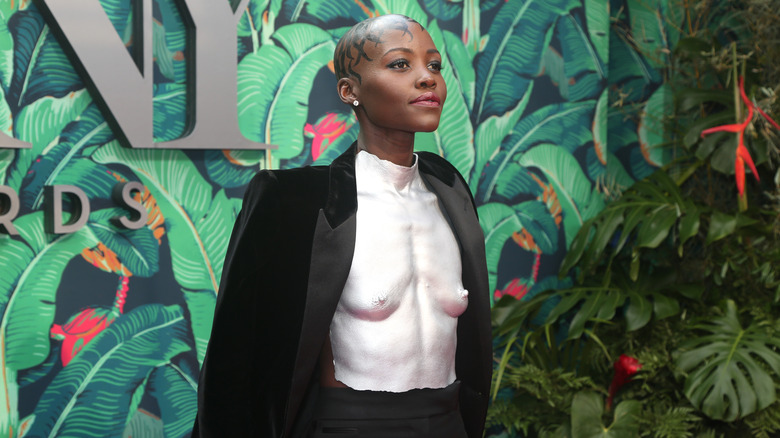Lupita Nyong'o's Custom Breastplate Tackles The Shame Associated With Female Bodies
Lupita Nyong'o arrived at the 2023 Tony Awards in a silver breastplate created by Pakistani artist Misha Japanwala. Nyong'o paired the piece with a black tuxedo and sported henna art on her shaved head. The breastplate was cast from Nyong'o's chest, and the final piece of art was an exact replica of her body, with no changes made. So Nyong'o's aesthetic that night was her exact body, simply in a breastplate form. On Instagram, Nyong'o called the night "A SHAMELESS OUT-OF-BODY EXPERIENCE" and thanked artist Japanwala for making art that celebrates the unfiltered body.
Nyong'o quoted Japanwala in her caption. "The word 'beghairat' (translation: shameless) has become an anchor in my practice; thousands of people have used it to describe me and the work I create, in an effort to insult and shame me into silence," Japanwala explained. The artist added, "My craft pertains to documenting our existence in the most truthful way I possibly can — I change nothing about the body and how it looks. I think that act of surrendering and allowing our bodies to simply be, is such a beautiful and powerful thing."
Much of Japanwala's art has to do with breastplates of marginalized bodies, taking the term "body of work" to a whole new level and tapping into deeply-rooted shame. Nyong'o's breastplate was a radical act of self-love and worn in direct combat to the shame that hits so many women around their bodies.
Lupita Nyong'o's breastplate celebrates the body now
Lupita Nyong'o's breastplate at the 2023 Tony Awards was a compelling moment of fashion blending with art. Artist Misha Japanwala's untouched recreation of Nyong'o's body literally offered an out-of-body experience. She was wearing her body on her body as both art and a garment. The experience was deeply meaningful to Nyong'o, who wrote on Instagram: "Misha, thank you for this special opportunity to BE EXACTLY HERE, IN THIS BODY NOW."
"Now" is exactly the point of this work of art. The timelessness of the breastplate means that Nyong'o's body is captured forever in time exactly as it is. For many, women especially, the tortured relationships that we have with our bodies push us out of the present. We're tempted to think after we lose x amount of pounds, then our body will be good enough. Ambitious sizing plays a part in this. After the body is edited, photoshopped, or worked on, then it's enough.
Cultural obsession with the narrow definition of the ideal female body means that many women are not able to live in the here and now with their bodies and celebrate them unchanged. In Japanwala's work, there's no patience for altering or "perfecting" the body. On social media, Nyong'o shared a video of how her breastplate was cast, a fascinating process of liquid layers finalized with plaster. The process of creating the breastplate was dynamic, while the art is immovable, frozen in time, creating a palpable tension between art and the ever-changing body.
Lupita Nyong'o wears armor over her body as criticism rolls in
Public reaction to Lupita Nyong'o's breastplate was vitriolic. Her posts on Instagram were flooded with comments from people who claimed that she had exposed too much of herself. Interestingly, no one could say that she had exposed too much skin, since that was completely covered. It was the realism of the breastplate that made people upset.
What was evident was that Japanwala's work, and Nyong'o's bold style, got bogged down by the free-the-nipple conversation, which was tedious. People lost sight of the deeper discussion at hand because of their fixation on the nipple details. The point was to celebrate the body without the tension of seeing it as a work in progress. The fact that the sculpture "freezes" the body in time points to this. The art is made, the silver is cast; the body does not need to change. It can simply be, as it is. And the present body is so wonderful that it's art.
The fact that the piece of art is a breastplate is fascinating; Nyong'o is literally wearing armor over her body, offering a rich reading of cultural commentary and scrutiny. No doubt she predicted that the piece would get pushback, which it certainly did. The armor is a compelling juxtaposition: she's protecting herself from social scrutiny and shame by wearing the exact form that our culture teaches us to be ashamed of.


